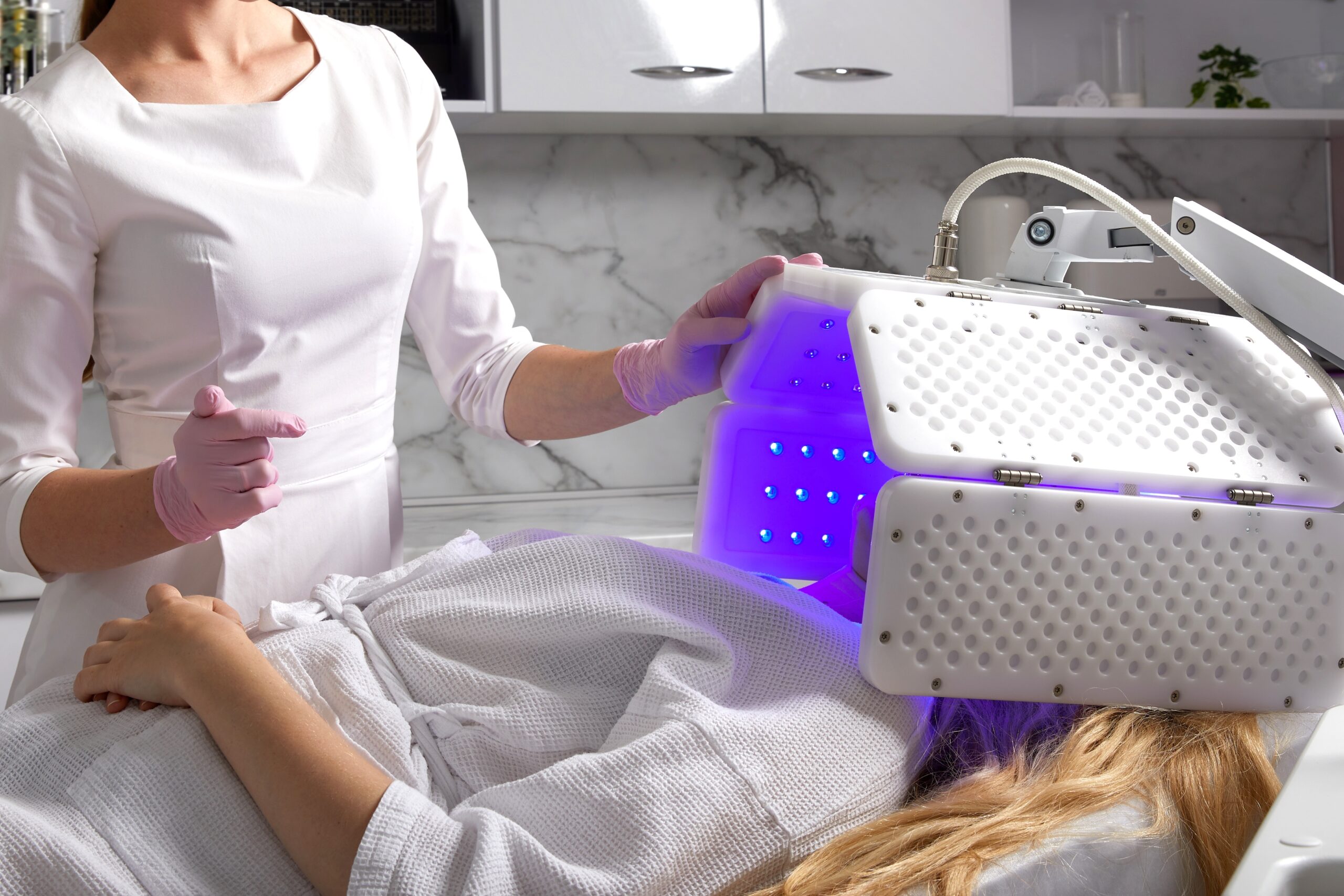Have you read about blue light therapy and wondered if it’s right for your skin? First of all, what is blue light therapy? Blue light therapy or photodynamic therapy (PDT) is an in-office procedure that is FDA-approved for the treatment of precancerous lesions known as actinic keratoses. It is also used frequently off-label for the treatment of acne and photorejuvenation (treatment of fine lines and uneven skin texture)! Instead of applying creams to your face for weeks to months, you may see improvement after just one session of blue light therapy! I am going to discuss how it works, what to expect during and after treatment, the benefits of blue light therapy, and if it might be right for you.
What to expect during treatment
You typically come into the office with a clean face. A medical assistant will then scrub your face further with some type of exfoliant such as gauze soaked with acetone. The goal is to remove as much dirt and oil from your face as possible. Next, someone will apply a photosensitizing gel placed to the areas of your face that are going to be treated. You then have to wait an hour for your skin to absorb the gel. So, make sure to bring a book or a laptop to get your work done! After the hour is up someone will wipe the gel off, and will provide you with goggles to put on to protect your eyes. You will then sit under the blue light for approximately 16 minutes. The wavelength activates the gel-absorbed skin and effectively treats precancerous lesions by causing a chemical reaction. For acne or photorejuvenation, the mechanism of action is not completely understood but continues to be used off-label. One theory is that it is killing the bacteria that cause acne. You can expect a burning sensation during treatment. The severity of that burning sensation depends on your level of sun damage.
Essential information on aftercare
I tell my patients that you can expect a sunburn-like reaction after the treatment. The severity of the reaction once again depends on your level of sun damage. The most important part of this procedure (besides protecting your eyes with goggles) is that you absolutely MUST avoid the sun for 48 hours after the treatment. This includes indirect light through car windows, windows in your home, or even extra bright lights in your house or a building. If you were to expose yourself to the sun then you could develop a severe sunburn-like reaction even with blistering! For this reason, my medical assistant always applies a thick layer of sunscreen before our PDT patients leave the office. I generally recommend patients wait until the fall or winter to have this procedure to minimize the risk of sun exposure. If you experience a lot of discomfort following the procedure, it is okay to apply plain Vaseline to soothe it. Occasionally, patients will continue to have discomfort. I recommend talking with the provider who performed the procedure if the discomfort is severe.
Benefits of blue light therapy
What can it do for your skin? One, it can destroy precancerous lesions known as actinic keratoses. The goal of this is to prevent the precancers from turning into skin cancer. While the treatment is effective, there is always a possibility that you will grow some more. Along with the treatment of precancerous lesions, blue light therapy can improve the texture of your skin. It can help with some very fine lines and soften up some wrinkles. Overall leading to a younger appearing version of you! Turning back the clock for five or more years? Yes, please!
Is it right for you?
Blue light therapy can provide a lot of benefits for your skin. I have had many patients happy with their results. One lady said her face had never felt so smooth! Most insurance companies will typically cover it for the treatment of precancerous lesions. However, off-label treatment for acne or photorejuvenation, like many other cosmetic treatments, can be expensive. Interested in learning about free ways to improve your acne? Read more here. If you are taking certain medications that already make you photosensitive or you have a history of frequent cold sores then the treatment may not be a good option for you. As always this information is to provide you with the basic knowledge you may need to be an informed patient so you know what questions to ask at your next appointment.
Have you tried blue light therapy? If so comment below with your results and if it is something you would do again!
*Disclaimer: Opinions expressed are solely my own and do not express the views or opinions of my employer. Information on this website is for education and entertainment purposes only. Content is my opinion. It is not substituted for your own doctor’s medical care or advice. One should not make any health or medical-related decisions based in whole or in part on any content on this site. Content is not intended to replace the services of a licensed, trained health professional. Content may not apply to you as an individual. Although I will update my website with current information, this website is not a definitive guide to dermatology.

View comments
+ Leave a comment